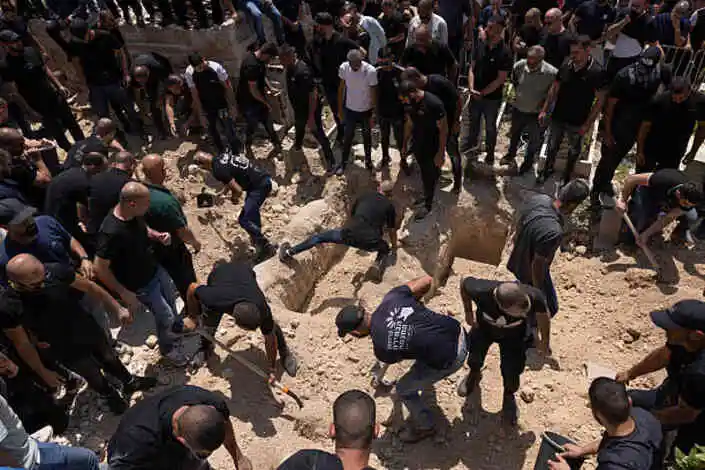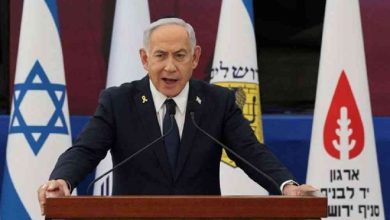Crisis Unfolds: Israel-Iran War Ignites Global Politics
As Hamas calls for an end to war, the Trump-Iran conflict escalates, threatening U.S. military action and reshaping the Middle East crisis in 2025.

In the heart of Tehran, smoke chokes the skyline, a grim testament to the Israel-Iran war that erupted on June 13, 2025. As Hamas calls for an end to war, the Trump-Iran conflict teeters on the edge of U.S. military action, sending shockwaves through global politics. This Middle East crisis, now in its seventh day as of June 20, 2025, has killed over 200 in Iran and 24 in Israel, with both sides trading missile strikes that threaten to destabilize the region and beyond. This article dives into the human toll, geopolitical ripple effects, and underreported local impacts, offering a raw, urgent look at a conflict reshaping the world.
A War Ignited: Israel’s Surprise Strike
On June 13, 2025, Israel launched Operation Rising Lion, a surprise assault targeting Iran’s nuclear facilities and ballistic missile sites. Prime Minister Benjamin Netanyahu justified the attack, citing “existential” threats from Iran’s nuclear program. The operation, meticulously planned since September 2024 after the assassination of Hezbollah leader Hassan Nasrallah, hit key sites like the Fordow Fuel Enrichment Plant and killed top Iranian nuclear scientists and military leaders. Iran’s Foreign Minister Abbas Araghchi called it a “declaration of war,” vowing retaliation.
By June 20, Israel claimed to have destroyed half of Iran’s ballistic missile launchers, reducing Iranian barrages from 40 missiles to mere handfuls. Yet, Iran’s retaliatory strikes, including a devastating missile attack on Beersheba’s Soroka Medical Center on June 19, have escalated the stakes. The hospital’s surgical ward was crippled, forcing patients to rest outdoors amidst debris.
Hamas’s Plea Amidst Chaos
Hamas, battered by Israel’s renewed Gaza campaign since March 18, 2025, has called for an immediate end to hostilities, a plea echoing its November 2024 statement after Trump’s election win. The group, an Iran-backed proxy, sees the Israel-Iran war as a dangerous escalation that could further devastate Gaza, where 144 were killed in recent strikes. This call, largely drowned out by the roar of missiles, reflects Hamas’s weakened position after Israel’s relentless attacks on Iran’s regional allies, including Hezbollah and the Houthis.
In Gaza, families like that of Amina al-Rahim, a 34-year-old mother of three, huddle in makeshift shelters. “We have no food, no water, and now this war with Iran makes it worse,” she told Al Jazeera. Her story, rarely highlighted, underscores the human cost of a conflict fueled by geopolitical chess moves.
Trump’s Tightrope: Diplomacy or War?
President Donald Trump, navigating a volatile global political landscape, faces a defining moment. On June 18, he demanded Iran’s “unconditional surrender,” warning of U.S. military action if Tehran didn’t dismantle its nuclear program. Yet, he’s also pushed for diplomacy, giving a two-week window until July 4, 2025, to resolve the crisis. His envoy, Steve Witkoff, has held talks with Iran’s Araghchi, though no meetings are confirmed.
Trump’s rhetoric swings wildly. On June 16, he posted on Truth Social, “We can easily get a deal done between Iran and Israel, and end this bloody conflict!!!” By June 19, he was in the White House war room, mulling a strike that could drag the U.S. into a war he vowed to avoid. This contradiction has split his base, with hawks like Senator Lindsey Graham pushing for action and isolationists urging restraint.
A lesser-known detail: Trump vetoed an Israeli plan to assassinate Iran’s Supreme Leader Ayatollah Ali Khamenei, signaling a cautious approach despite his bluster. Khamenei, defiant, warned of “irreparable consequences” if the U.S. joins the fray, threatening attacks on American bases.
The Human Toll: Lives Upended
In Tehran, the air is thick with fear. “I didn’t expect this to happen so fast,” said Li Wei, a Chinese engineer working for an oil company, who fled to Armenia after a 30-hour journey stalled by military checkpoints. Iran’s health ministry reports 224 deaths from Israeli strikes, including two state TV employees killed in a June 19 attack on Tehran’s broadcasting headquarters.
In Israel, the mood is equally grim. A missile strike near Tel Aviv on June 15 killed 10, with residents scrambling to shelters as air defenses struggled. At Soroka Medical Center, nurse Rachel Cohen described chaos: “We moved patients to the parking lot. The surgical ward is gone.” Israel’s fortified blood bank, activated post-October 2023 Hamas attacks, is now stretched thin.
Underreported: Iran’s civilian toll includes 15 children killed in a Tehran residential strike, per a UNICEF brief not widely covered. In Gaza, the conflict’s ripple effects have cut humanitarian aid by 40% since March, leaving 1.2 million without basic supplies, according to UN News. These stats paint a stark picture of a crisis bleeding across borders.
Geopolitical Ripples: A Region on Edge
The Israel-Iran war threatens to redraw the Middle East’s power map. Iran’s “axis of resistance”—Hezbollah, Hamas, and Iraqi militias—has been weakened, with Israel claiming air superiority from western Iran to Tehran. Yet, Iran’s proxies remain a threat. An Iraqi militia vowed to strike U.S. bases if Trump intervenes, a warning echoed by Khamenei.
Oil markets are jittery. Strikes on Iran’s refineries, like one near Tehran on June 17, have disrupted 12% of its oil exports, per Bloomberg. A potential closure of the Strait of Hormuz could spike global oil prices by 20%, analysts warn, triggering an economic crisis felt from Tokyo to New York.
China, Iran’s top oil buyer, condemned Israel’s strikes and offered mediation, seeing the conflict as a chance to counter U.S. influence. Russia, with workers at Iran’s Bushehr nuclear plant, has also pushed for talks, with Putin assuring their safety. These moves highlight a broader geopolitical chess game, where the Middle East crisis could shift global alliances.
What It Means Now: Immediate Impacts
The Middle East crisis is a powder keg. Economically, oil price volatility threatens global markets, with Brent crude already up 8% since June 13. Humanitarian needs are dire: 1.5 million Iranians are displaced in Tehran alone, per UNHCR, while Gaza’s aid pipelines are collapsing.
Geopolitically, Trump’s decision by July 4 will shape U.S. credibility. A strike risks alienating allies like the UK, whose Foreign Secretary David Lammy sees a “window” for diplomacy. A failure to act could embolden Iran, whose nuclear program, though damaged, remains a threat.
Locally, Iran’s regime faces unprecedented pressure. Israel’s strikes have killed top officials, and Netanyahu hints at regime change. Yet, analysts warn that toppling Iran’s government could spark chaos, displacing millions and destabilizing Iraq and Syria.
Underreported Angles: The Forgotten Voices
While headlines focus on missiles and Trump’s ultimatums, lesser-known stories reveal the crisis’s depth. In Iran’s Kolesh Taleshan village, the IDF issued evacuation warnings on June 19, displacing 2,000 residents, per a local NGO report not widely covered. In Gaza, fishermen like Mahmoud Khalil can’t work due to naval blockades, cutting livelihoods for 4,000 families, according to a UN Food and Agriculture Organization brief.
Another overlooked impact: Iran’s Chinese diaspora, numbering 10,000, is fleeing en masse, disrupting Beijing’s Belt and Road projects. These human stories, buried under military updates, show the crisis’s far-reaching toll.
Global Diplomacy: A Fading Hope?
International calls for peace are growing but faltering. The G7, in a June 16 statement, urged de-escalation, with Trump signing on after tweaks to avoid endorsing a ceasefire he called insufficient. Russia and China push mediation, but Iran’s refusal to negotiate under fire, coupled with Israel’s vow for “total victory,” dims prospects. A source close to the talks, cited by Reuters, noted, “Iran’s position is firm: no talks under bombardment.”:
The Bigger Picture: A World Watching
The Israel-Iran war isn’t just a regional conflict—it’s a global political flashpoint. A U.S. strike could deter China’s Taiwan ambitions or bolster Putin’s view of American resolve, per the Washington Examiner. Conversely, restraint could signal weakness, emboldening Iran’s proxies.
In the U.S., Congress is divided. Senator Tim Kaine’s June 16 resolution to block unauthorized U.S. military action against Iran echoes a failed 2020 effort post-Soleimani. With Republicans resisting curbs on Trump’s war powers, the risk of escalation looms.
The Road Ahead: July 4 Deadline Looms
As Trump’s two-week deadline nears, the world holds its breath. Will he opt for diplomacy, as urged by allies, or join Israel in a war that could engulf the Middle East? The USS Nimitz carrier group’s move to the region signals preparedness, but Pentagon officials insist it’s for “defensive posture.”
For Iranians like Li Wei, Israelis like Rachel Cohen, and Gazans like Amina al-Rahim, the stakes are personal. Their lives, disrupted by a conflict they didn’t choose, hang in the balance of decisions made in Washington, Jerusalem, and Tehran. The Middle East crisis, fueled by decades of enmity, shows no easy resolution.
Stay sharp with Ongoing Now 24.





